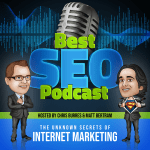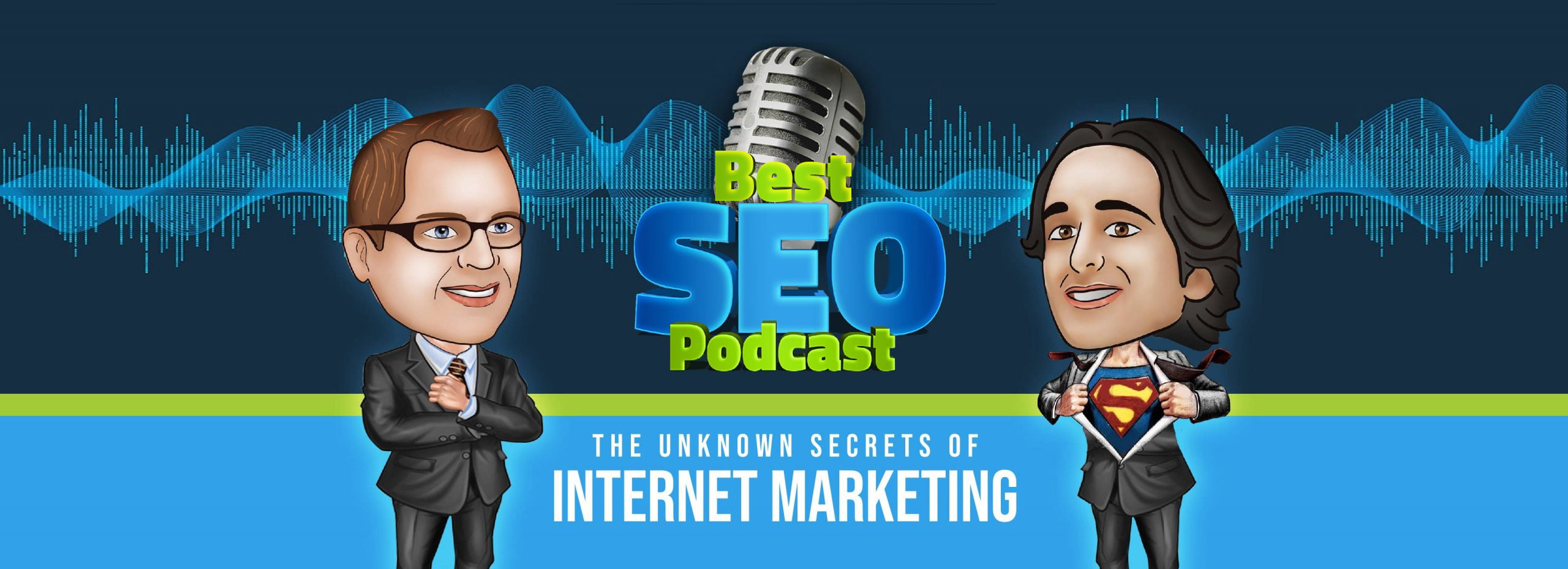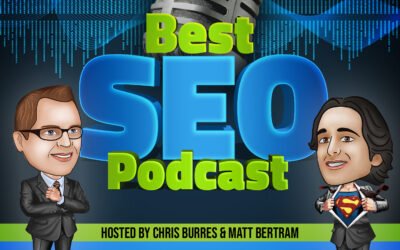

Video Transcript
Chris: Hi and welcome to the SEO Podcast: Unknown Secrets of Internet Marketing. My name is Chris Burres, owner of eWebResults.
Matt: My name is Matt Bertram.
Chris: Yes, it is.
Matt: That’s it. I’m just meeting today.
Chris: Today, just met. Welcome to another fun-filled edition of our podcast, this is podcast number 405.
Matt: Five!
Chris: Yes, we have done 405 podcasts. They’re about 30 minutes each, millions of– at least a million downloads of our podcast. 15 thousand users trust us in our market strategies to get you results.
Matt: Come on, read the USP!
Chris: To get you results, and higher sales, and lower cost of acquisition, and piece of mind.
Matt: For our customers.
Chris: For our customers.
Matt: Nice job.
Chris: Print. Seriously, welcome back to another fun-filled edition. As always we have a tip from our previous podcast, and that tip is…
Matt: The tip is just block the apps. Just block the apps and– just block them all, really.
Chris: When you’re doing AdWords display– which camera am I talking to?
Matt: I don’t know.
Chris: Block all of the display ads in apps ‘cause they’re useless, you don’t get conversions.
Matt: iOS, Android, you don’t really need them depending on if you’re not doing gaming stuff.
Chris: Yeah,
Matt: Typically 95% of the time you don’t need them.
Chris: Yeah, unless you’re selling games. Subscribe. Follow.
Chris & Matt: Boom!
Chris: Alright, hand me that back otherwise this show will not go very far ‘cause we really won’t know what to do. Remember we are broadcasting live here in Houston, Texas. And Matt and I, we are your…
Chris & Matt: Results Rebels.
Chris: We need like an R.
Matt: I want an a H.
Chris: This is the H.
Matt: Like H for H-Town.
Chris: H-Town is this one.
Matt: Is that from University of Houston? Because that’s a longhorn symbol.
Chris: Houston is this one. No, I thought longhorn was this way.
Matt: There’s a lot of these things here.
Chris: Right, so this is longhorn, this is H-Town–
Matt: And then cowabunga? Or what is that one? I don’t know.
Chris: No, this one’s like a hang ten.
Matt: Okay, hang ten.
Chris: Hang ten and then the other one we don’t wanna…
Matt: Yeah we don’t wanna use that one.
Chris: That is not working.
Matt: I don’t know what all of these symbols are.
Chris: That is not our company hand sign. Hey, before we really jump into anything I wanted to read this review. This is from John B and he’s helped us out, it’s on Yelp! And it is of course…
Chris & Matt: 5 stars!
Chris: And it says, “I found eWebResults by their podcast, enjoyed listening to their ideas on ways to improve my business and think they provide a lot of value. I did a free 15-minute call with Aaron Weathers!”
Matt: Whaaat! Yeah! Shout-out to Aaron!
Chris: Shout-out. Punch in the face to Aaron as well. “And I am really glad I did. He was very helpful and I’m open to plug into their services soon.” John, we are hoping you will plug into our services soon as well. And punch in the face to you for that great review.
Matt: Shout-out to Jeanie.
Chris: We really appreciate that.
Matt: We just talked to you today, Jeanie punch in the face to you. She punched in the face back, so awesome job.
Chris: Hey, we’ve got a great article we’re talking about today. The article is, “Mobile marketing checklist you need for 2018.” It is by Sergey Brybinak, Brybanak. I’m gonna go with Brybanak.
Matt: Okay.
Chris: Brybniak.
Matt: I’ll go with that.
Chris: Brybniak, I’m going with Brybniak.
Matt: Alright.
Chris: If you are in a position where you have some sort of electronic device, and you can tweet, what we’d like you to do is tweet and include #SEOPodcast, @BestSEOPodcast, @eWebResults, and also include Sergey Brisniak. And his symbol is, his Twitter handle is @G-R-Y-B-N-I-A-K (@Grybniak).
Matt: Sergey, awesome job on the article.
Chris: Yeah.
Matt: Excited to jump into it.
Chris: Really good article. Hey, if this is the first time you’re listening to the podcast: howdy, welcome to the podcast. You’re gonna have a great time. We’re from Texas, that’s why we say howdy. If you’ve listened to this podcast before, you know what we’re gonna skip!
Matt: Yeah!
Chris: Each week we run a contest, the contest has two components. The first component is we need to get 10 shikos.
Matt: A share, a like and a follow.
Chris: A share, a like and a follow.
Matt: That’s not very Texan actually.
Chris: No, that was–
Matt: So give me the share, the like and the follow.
Chris: A share, a like, and a follow.
Matt: Boom!
Chris: Yeah. If you give us a share, a like and follow – that’s 10 of them – and we get a review, then we actually move the part where we tell you how to connect with us and give us reviews to the end of the podcast. We’re doing that today. What we will say– what will we say?
Matt: I don’t know, what do you wanna say?
Chris: Oh! If you get value out of this podcast– hey Aaron could you do me a favor and turn up the AC please? If you get value out of this podcast, what we would like– you probably would be interested I don’t know, in say, 5 online marketing mistakes that you could make that could tank your business, and how to avoid them. It’s a free article, you can have it. All you need to do is go to eWebResults.com/SEOTip.
Matt: So one of the interesting things is based on open rates.
Chris: Right.
Matt: Negative open rates. Or negative titles work way better than positive titles for open rates.
Chris: Really?
Matt: Yeah.
Chris: Wow.
Matt: That’s what I’m really starting to see.
Chris: Because we debated on this one.
Matt: We did.
Chris: Yeah.
Matt: And we have some content writers that like to write negative and clients that wanna write positive, and based on open rates, we’re starting to see really a trend that negative open rates are better because people just like have to read it. They wanna know the inside.
Chris: How do they protect themselves?
Matt: Yeah, yeah. Exactly.
Chris: It’s probably related to that human nature where you have a higher concern about loss than potential gain, right? So negative is about potential losses you could experience, and positives are actually about potential gains you could get. So it’s just human nature. Alright, so we’ve done that. We said howdy. We’re gonna say–
Matt: Howdy again from Texas!
Chris: We do have a free website– we have a free website– don’t hold it against him. Sorry. We do have a free website analysis. All you need to do is go to eWebResults.com and click the button that says free website analysis. You can get that process started. I like to cover a little bit of news before we get into the podcast, I got three pieces of news. One is MoviePass, I don’t know if you’re familiar with MoviePass, but they’re pulling out of some AMC locations. Do you know what? Have you heard of MoviePass?
Matt: I’m guessing what it is, I don’t use MoviePass.
Chris: I don’t use it either. I hadn’t even actually heard of it. Apparently you can pay like a monthly subscription and that gives you access to actually go to the movie theater. So they’re trying to–
Matt: Very cool.
Chris: Kind of like a Netflix thing, except you go to the movie theater, which is kinda cool. They’re pulling–
Matt: The lady we interviewed yesterday worked at Netflix before no one– like no one had heard of Netflix. It was pretty cool.
Chris: She was like, “where do you work?” “Netflix.” “Oh, is that another–?”
Matt: She laughed, she was like ah–
Chris: Bomb dot com. Did I turn out? Yeah, bomb dot com. Anyway, so they’re pulling out and really what they’re realizing is MoviePass in not interested in getting people to the theater; it’s interested in creating a list of people that they can then market their streaming service to later.
Matt: Smart.
Chris: Pretty smart. Surprise! Next, Google will let people mute their remarketing.
Matt: Gasp!
Chris: It’s a little scary isn’t it? Yeah.
Matt: That’s very scary.
Chris: It’s funny ‘cause the article I read called it reminder ads, right? We call it remarketing. What’s interesting is Amazon and Facebook obviously will not be affected because Google is making decisions on their own products. There should be no concern when you mute an ad, another ad will show up, it just won’t be a remarketing ad. I think I’d rather have remarketing ads than regular ads.
Matt: They’re relevant, yeah.
Chris: And then finally self–
Matt: We can still get you.
Chris: Self-driving shuttle bus is in a crash on the first day of service. It’s one of the Google bus’ first day. It was not the bus’ fault or the software, it was the fault of somebody else who just ran into the bus.
Matt: So here’s something.
Chris: Yeah?
Matt: So when the Astros won– whoo!
Chris: Okay, yeah they did. Go ‘stros!
Matt: Like I cut the cord with cable a long time ago.
Chris: Right.
Matt: So I did Google TV, they did like a free–
Chris: In order to get the Astros’ game? Right, yeah.
Matt: Yeah, and get the Astros. Most of the ads are all Google ads that were being advertised in the beginning, right? They’re starting to get some people–
Chris: Some momentum, attraction, yeah.
Matt: So I just think it’s hilarious that their phone is called the Pixel 2.
Chris: Right.
Matt: Like what’s a pixel? Like it’s basically you’re a target. We got you, we got all your information.
Chris: So the pixel is like the tiniest– it’s interesting ‘cause like for different reasons–
Matt: They don’t call it a pixel, but I mean–
Chris: Well, it’s the tiniest thing on a screen, right? So you get like one pixel out.
Matt: Okay, okay.
Chris: So it’s interesting. Yeah, I still think the name’s bad. There’s two– you’re talking about the Facebook pixel.
Matt: Like you can just remarket, you know? They’re just following you around, got all your data, that’s how I’m thinking about it. I think they’re kinda poking fun at the consumer, but I see what you’re saying too. I mean that’s where my head goes.
Chris: Well, but even the pixel doesn’t make sense, right? So why would you want to buy the phone that is the very smallest piece of a–
Matt: A very small phone. Because the phones, we want big phones.
Chris: Yeah, exactly. Kind of weird.
Matt: Yeah, I don’t know.
Chris: Yeah. They should’ve just called it the retargeting phone apparently. Alright, so we’ve got this article. The article is the “Mobile marketing checklist you need for 2018.” Again, punch in the face to Sergey Braybniak, Brybniak. I’m gonna go with Brybniak this time I pronounce it.
Matt: Just go with his first name.
Chris: So he goes, “Businesses have no choice but to adjust their digital marketing campaigns to a new reality of mobile-driven marketing.” Absolutely. And we’ve actually got some interesting things we’ll be talking about that we’ve come to understand about mobile. How important it is, and where it’s actually less important than a lot of people think. So we’re gonna talk about that.
So let’s talk about “Global marketing trends.” “68% of marketing leaders use mobile campaign management tools,” already. Right? Already. And then here’s a couple other– so we’ll just throw these out to really kind of wet your whistle, get you excited about the fact that we’re talking about mobile marketing. It’s, “83% of all traffic in the US will be mobile by 2018.” That was according to Zenith.
Matt: What year is it?
Chris: 2018.
Matt: Oh!
Chris: Yeah, 82%. We’re not there yet. I don’t think we’ll be there by the end of this year, and we’ll talk about that in a second. “50% of US customers will conduct all their online activities on a mobile device by 2018.” No, I don’t think that’s true. I don’t feel like– I know that there’s a lot of other countries where all of it’s mobile, but man, there’s partly a lot. Like kids aren’t getting on computers, they’re maybe getting on a tablet.
Matt: Well I mean, if you look at– in what population demographic?
Chris: Right, that’s true. It depends. “By 2019, nearly 72% of digital ad spending in the US will be allocated for mobile platforms.”
Matt: I believe that.
Chris: Yeah, probably. Especially when you’re thinking about making instant purchases and stuff like that, ‘cause what we find– we’ll save that for later. “By 2021, over $1 trillion will be spent worldwide to adapt websites and applications to the realities of the mobile-first world.”
Matt: Back out the truck.
Chris: Yeah. That’s good for business. Thank you Sergey, I like that stat. It wasn’t your stat, but– So here we go, “Mobile marketing checklist for 2018.” Number 1– So this is– how many is this? It’s five? Is it five? It’s four. Of these four points, number 1 is, “Ensure your sites and apps are mobile-friendly.” This specifically includes, “Responsive design and excellent load times.” By the way, there will be a theme throughout this podcast, and the theme of the day is: quick loading website. Yeah. Fast loading website.
Matt: That is mobile. That’s mobile marketing.
Chris: That’s the overall theme.
Matt: Oh okay.
Chris: That’s the H1, is mobile.
Matt: Okay, okay.
Chris: The H, we’ll call it H3 probably.
Matt: Okay.
Chris: It’ll keep coming up. Alright, so less than five preferably– they look for load times less than five, preferably three. Yeah, we look for like three-second load times. Like that’s pushing it.
Matt: The faster the better.
Chris: So here’s an interesting stat. So if your page load time transitions from one second to seven seconds in a linear fashion, you will get bounce rates that increase 113%. So from one second to seven seconds, more than double of your traffic is bouncing immediately, your bounce rate doubles.
Matt: I can tell you, if a site doesn’t load in like three seconds, I leave.
Chris: Yeah, you’re outta there. Absolutely. Next is, “Impeccable UX/UI.” User Experience, user interface. Users no longer tolerate these things: “non-optimized, poor–” what is it? Non-optimized?
Matt: Non-optimized. No! No! No!
Chris: “Non-optimized, poorly navigable pages.”
Matt: Yes.
Chris: “Unclickable buttons and tabs.”
Matt: Oh I hate that.
Chris: “Images that do not fit on the page.”
Matt: Arrggh! You gotta scroll.
Chris: “Unreadable content that requires zooming.” All of these can be the– you know.
Matt: I mean there’s some upsides, when you gotta go, you gotta go. And they gotta click.
Chris: Don’t need that.
Matt: Oh ah, painful.
Chris: Alright. And then finally under the, “Ensure your sites and apps are mobile-friendly,” “Great mobile search optimization.” So he gave a list here and I’m gonna just– the really key one: “titles and meta descriptions – make them shorter to optimize for lesser screen space.” I’m not convinced of that.
Matt: I was gonna ask you to talk about that a little bit more, yeah.
Chris: Yeah. And actually I’ve got another one. I’ve got absolute questions. And so we’ll cover that a little bit later. Just remember pretty soon we’re gonna be mobile first indexing, so he may not have kind of taken that into consideration, because if titles and meta descriptions are useful for optimization– and by the way when I was reading this, I did read an article that was saying, having the keyword in the title, in the H1 and in the description is becoming less of a correlative factor in good placement, right? So it’s more about the content and less about how are you manipulating the little tools.
Matt: Use the semantic learning tool. I mean it’s about, is this talking about the same topic?
Chris: Yeah.
Matt: Not is the word in there and density.
Chris: Exactly right, yeah. And then, “Implement structured data markup to help search engines trigger ‘rich snippets’.” Structured markup, we actually mentioned that in our podcast when we were doing kind of the projections over 2018. That’s two podcasts ago, that was a really good podcast. Alright, number 2. This is number 2 of the “Mobile marketing checklist you need for 2018.”
Matt: If you wanna have us on your podcast, do some outreach.
Chris: Yeah, absolutely. “Optimize and personalize content for mobile devices.” So this gets really interesting. “Optimization of content pages that are slow to load and hard to navigate. Update your mobile design and implement Accelerated Mobile Pages (AMP).” So interesting, we had the founder of Search Engine Journal on two podcasts ago, and one of the things he brought up is– well we brought up kind of in terms of–
Matt: AMP.
Chris: Huh?
Matt: AMP, is that where you’re going?
Chris: Yes, AMP.
Matt: Okay.
Chris: Was Accelerated Mobile Pages, AMP. And he talked about how it’s a frustration not just– so he, as the founder of Search Engine Journal, certainly needed to keep in mind that AMP pages were important for that business, but has also seen lots of other businesses invest a lot of money, lose a lot of money trying to implement AMP pages. So he wasn’t that favorable on the whole AMP page thing. And it has less– there’s less things you can do with AMP pages.
Matt: I mean I think just getting a dedicated server, optimizing the images.
Chris: Make sure it goes fast.
Matt: Yeah.
Chris: Yeah. Yup. Wait, isn’t that our H3? Is speed, load speed? Yeah. So number 2 out of this, and this is the very specific, “Optimize and personalize content for mobile devices.” “Optimization of mobile content for voice search.” So we keep hearing voice search, voice search. And we know, like how many times do you search via voice? I think you Googled five times today. You were on your phone like searching voice.
Matt: Well, I’m also seeing in the AdWords, Siri, and like Google tell me– like I’m starting to see quite a little bit of it.
Chris: People trying to catch that.
Matt: Well, it’s interesting how we’re having to frame it, but definitely people are using it.
Chris: He says, “Use more natural, long-tail keywords, and implement Schema.” He did say implement Schema again. Absolutely, implementing Schema is a good thing. So here’s something that’s a little more specific, right? He says, “Users crave specialized and personalized content: emails, instant app messages, and SMS. All of these elements have amazing open rates.” For example, SMS has a 98% opening rate, and, if delivered–
Matt: I’ve been saying that for so long.
Chris: You have, yeah. “And, if delivered during so-called micro-moments, they can dramatically increase conversions and ROI.” So you can think if you’ve engaged them, and you’ve almost got them converted, and you get that nice SMS message to them – that’s a micro-moment as he describes it – then you’ve got an increased conversion.
Matt: Well, we’re working on building these email automations that are three prongs right now. So it’s the emails which is just the solid workhorse, and then we got the text messages that we’ll shoot off in the automation.
Chris: Right.
Matt: And then the direct mail. So we’re expanding outside of just the internet, but we’ve seen a really good response rate from direct mail.
Chris: Yup.
Matt: So, just head’s up.
Chris: Excellent. One last thing, note: “AI-powered chatbots are also becoming essential to instant messaging apps.” I gotta get another punch in the face to Aaron ‘cause he’s been working on our chatbots and it’s kinda sexy.
Matt: We’re tip of the spear.
Chris: Yeah.
Matt: eWebResults’s tip of the spear.
Chris: Tip of the spear. Alright number 3 of the “Mobile marketing checklist you need for 2018.” Number 3 is, “Prioritize local optimization.” So he had a couple points here. The first one he said, “Use shorter keywords for organic searches; optimize for longer, more natural keywords for voice searches.” I don’t know how you’re distinguishing these, and I think shorter words in general– like I think we all covet shorter words in general, right? Because it’s the shorter words that tend to get more search volume as opposed to the long-tail phrases. So I don’t know. Just like the previous one when we’re talking about a shorter title, or a shorter description, I’m not sure. Now, what you should be aware of as you’re writing this description, understand on a mobile device where is it gonna get cut off? Because it will get cut off. And so maybe it should be that it has the same length that is required to do well on a desktop – and I’ll talk about that in one second – and be written intelligently so you know that it’s gonna get cut off at whatever the word count is on a mobile device.
Matt: Well you know, it’s hard to know exactly what strategies he’s implementing when he’s saying this, ‘cause he doesn’t go into too much detail. Different strategies require– well, different strategies require different execution.
Chris: Right, right.
Matt: Right? And so we’re talking about tactics here, and it just depends on what’s in his head as far as strategies go, ‘cause I see what he’s saying in some instances and I definitely see what you’re saying.
Chris: Yeah, yeah. Again, how you’re implementing it makes a big difference.
Matt: Yeah.
Chris: And then the other thing that I was gonna say is: one thing that is absolutely true right now – may not be true at the end of 2018 – is more conversions actually happen on a desktop. That’s still true. Now, it’s certainly is on an industry by industry basis. In general the statistics are more conversions happen on a desktop. And certainly when you get into larger purchases, things that are more impactful in our redirections of your life, right? Not getting a burger, not ordering batteries, but you know, getting a pool cleaning service as an example.
Matt: A longer sales cycle. Anything with a longer sales cycle. You know you’re delivering a slower cadence, they have to think about it. Have definitely seen that.
Chris: Yeah, purchases happen on the workstation.
Matt: Still, and that was always kinda really my theory going into almost everything, but I’ve really started to see things are starting to happen on mobile.
Chris: More and more.
Matt: I mean, think about like Amazon and the app.
Chris: Oh yeah.
Matt: Like people are making purchases. It just depends on how much thought is going into that and how much research has to be done, I think is overall still true. But I can tell you, people are using their phones more and more, doing research and–
Chris: Yup. So the point is yeah, in the case of Manning Pool Service, our client here in town, they actually get more mobile traffic but more desktop conversions.
Matt: I mean that’s true for a number of the clients. I’m just telling you that that was my premise with almost everything.
Chris: And now it’s gonna be shifting, yup.
Matt: It’s shifting, yeah.
Chris: I think that’s absolutely true. The next one he suggested was, “Consider shortening the content of your info pages to 300-500 words.” And he’s talking about the about us page, product & services page, contact us page. I’m gonna say I don’t think that’s a good idea. I think if you’ve written 650+ words, which is a good target, it may not apply on a contact us page, it may not apply on an about us, it may not even apply in a particular product page, but if the product is competitive, you probably want that content. Don’t shorten it ‘cause people know, just make sure that you can scroll through it and read it, and maybe hide it accordingly.
Matt: I think we’re talking about– okay, so we’re talking about like SEO.
Chris: Right.
Matt: Right? Like longer pages for SEO, they can rank independently in Google, the longer the better, but then if you’re talking about direct response and you’re trying to make a conversion on mobile, I think that that’s maybe what he’s talking about. He’s talking about conversions. The only thing I can really add to this and I think it could go either way, is like the about us page in my opinion is one of the best places to sell. Okay? People don’t think of that.
Chris: You’re right, yeah.
Matt: But most people if you’re getting exposed to a business, they do check out the about us page, the kinda wanna know. Even the younger generations, more conscientiousness, more skeptical. And the about us page is big and I think it’s one of the best opportunities to sell that most businesses miss.
Chris: Right, yeah absolutely. Finally he says, “Add–” not finally, “Add your company name, address, and phone number to the header, footer, and sidebar.” Not on all three. And then, “Prioritize user experience over bot–” Experience, so he’s talking about: don’t worry so much about what the Google bot is experiencing, make sure that you’re delivering a good experience. And like we always say, if you’re delivering a good experience to the Google user, Google will like you.
Matt: Yes, yes.
Chris: And finally he says, “Make sure to claim and optimize your Google My Business listings.” I cannot cosign that more. That’s like step one. Like literally it’s step 1: get a Google My Business listing, step two: make my website. Like that’s the order. Do Google My Business first.
Matt: Yeah, and it’s surprising how many brick and mortar businesses out there that have been around for a long time, haven’t jumped on the bandwagon yet. And that could be just an easy, easy solution that you could implement for your clients or– I mean I know all of our podcast listeners already have done that.
Chris: If they aren’t, they should reach out to us.
Matt: But if you have clients, ‘cause a lot agencies listen. Or you’re starting an agency, right? That’s one of the easiest kind of things to help a business immediately and pack the results.
Chris: Absolutely. Alright, finally number 4. Again, this is the, “Mobile marketing checklist you need for 2018.” “Adjust your PPC & SMM campaigns for mobile.” It says, “Since few organic results fit in on a smartphone’s screen, investing resources into developing a paid search strategy makes perfect sense.” It’s possible to not have any organic listings on a mobile search result, right?
Matt: That’s Google’s goal.
Chris: Depending on the phone.
Matt: The whole first page is ads.
Chris: So he also– so we always talk about the actual description, so the meta description when you’re organic. That’s the piece that Google shows in your listing when you show up. And that’s your first opportunity to start selling, to start managing the expectation of the person who– “Hey, you’re gonna go here and you’re gonna order? Or you’re gonna go here and you’re gonna get a newsletter? Or you’re gonna here and take a picture. You know, whatever it is, he suggests adding phrases like “Purchase from your smartphone,” “Order from your mobile,” “Easy mobile leasing,” right? So they’re like, “Oh. That’s right, I am on a mobile device and I could purchase it right now.
Matt: Hold on. I haven’t done that.
Chris: “Create a compelling, mobile-focused ad copy. Include not only keywords, CTAs, and specifics–” which you have to have, but also think about adding phrases like: “purchase from your smartphone,” “order from your mobile,” “easy mobile leasing,” etc.
Matt: We’ve learned something.
Chris: Schedule from your mobile, right?
Matt: I’ve never done that. Yeah.
Chris: Next, “Use mobile ad extensions. Specifically, you should try sitelinks–” we talked about this like four podcasts ago, “Sitelinks, call extensions, click-to-call ads, and local extensions,” and promoted pins.
Matt: Message extensions, brand new.
Chris: Oh yeah, yeah.
Matt: They could text you 24/7. Well, only run your ads, okay? Only run your ads when you’re open, okay?
Chris: Yeah.
Matt: You’ll save a lot of money. Most people will bounce if they can’t get a hold of somebody on the phone, based on–
Chris: So wasted click, yeah.
Matt: Yeah, but you could add a click to text, like talk to somebody. And then I think that the location, the location pins?
Chris: Yeah.
Matt: That’s starting to be big, that’s fun. Just make sure you have the search partners clicked. Like don’t just do Google, or it won’t show up there.
Chris: Next, “Set up promoted pins.”
Matt: That’s what I meant. Yeah.
Chris: This puts logo on the Google map, which naturally increases visibility and accessibility.
Matt: That’s what I was talking about, yup.
Chris: And then finally he says use Google’s Smart Bidding tool. Do you have a comment on that?
Matt: Yeah. If you trust Google and you want them to–
Chris: Not just spend frivolously.
Matt: No, if you trust Google, and you wanna give your money to Google and just let them bid for you, go for it.
Chris: We’ll leave it at that. So he had a couple more stats related to social media marketing, “By 2019, nearly 80% of all mobile traffic will be video traffic (TubularInsights).” Now, that’s kinda not fair, right? Because you could pull down a webpage, and it could be a couple KBs, and you can watch a couple minutes of video and it’ll be a couple MBs, or GBs, right? So to say that 80% of mobile traffic is video traffic, I think it would be more interesting– what percentage of your time on your mobile device is video versus other things, right? Because of course 80% is video, like sit down and watch a Netflix video on your mobile device – which I’ve done, actually – and you’ve used a lot of bandwidth, right?
Matt: I was thinking when he said that, like this is not gonna be around for very long, it’s gonna move past this. But VR? Virtual reality, or augmented reality or whatever, we’re in the glasses. Like so you put your phone up, right? And I think that that’s gonna be a growth thing. It’s gonna be more, and more, and more.
Chris: Right.
Matt: And so when you said, mostly on your phone, well if you’re wearing your phone in your eyes…
Chris: Then it’s video.
Matt: Then it’s gonna be a lot.
Chris: Yeah.
Matt: A lot of time.
Chris: He says for social media marketing, “Run live streams and live videos. According to Facebook, live videos are three times more popular than regular videos.”
Matt: What are we doing right now?
Chris: Yeah, I believe we’re live on Facebook. Facebook Live?
Matt: Whoo!
Chris: As we should be. And then– I like this. He says, “Average person’s micro-moments are heavily dominated with mobile. Remember we mentioned micro-moments, those opportunities that we can really increase conversions. Those micro-moments tend to happen on the phone, right?
Matt: Yeah, yeah.
Chris: Man, you need to have a social media strategy ‘cause when people are on the phone, they’re actually on– he says, “96% percent of customers reach for their smartphones when they need to find something online, or simply want to distract themselves.”
Matt: Well, that’s the big thing with Facebook, okay? Everybody– not everybody, but a lot of people get Facebook wrong. And I know we’re not talking about Facebook advertising, but people go–
Chris: Well he is. Social media marketing.
Matt: People go to Facebook to escape, okay? They don’t wanna be sold something, it’s kind of selling from the front porch.
Chris: Right.
Matt: Right? And like you’re sitting there and you’re offering some cookies and lemonade, and want them to come up. You know, it’s a different kind of strategy than like shouting out at a stadium, “Hey I got–” that’s like Google.
Chris: Peanuts!
Matt: Yeah, peanuts! That’s like Google, right? So Facebook’s got a little more subtle strategy, gotta kind of entice them. You know, try to get their interest as they’re distracted.
Chris: There’s more cording on Facebook.
Matt: Yes! Yeah, yeah.
Chris: Yeah, absolutely. Hey, punch in the face to you Sergey Braybniak, Brybniak. Gryb– no, Grybniak. Grybniak. That’s how I’m pronouncing it this time. Forgive me for mispronouncing your name, if I did.
Matt: Sergey. Sergey.
Chris: Sergey,
Matt: See? I got it right.
Chris: I’m sure I mispronounce it. Hey, go ahead and tweet, tag him, it’s @G-R-Y-B-N-I-A-K and that’s the meat of our podcast.
Matt: Boom!
Chris: So we’re about to wrap up. If you liked this podcast, we do ask that you share it with three friends. We also ask that you leave us– the only place we’re asking you to leave us a review right now is on Yelp. Make sure you don’t tell Yelp that we’re asking you to leave a review on Yelp. Just leave a review on Yelp. We’ve made it easy to get to Yelp, just go to eWebResults.com/
Matt: Yelp.
Chris: Then you’re there. So we also as part of our weekly contest we need that review and we also need 10 shikos. Again a shiko is a…
Matt: You could say it’s–
Chris: Share–!
Matt: No! No, no.
Chris: A share, a like and a follow.
Matt: Yes! There! Yeah.
Chris: If we get those shares, likes and follows – 10 of them to be exact – and we get a review, then we do the section at the end, just like we’re doing right now.
Matt: Keep going in that accent.
Chris: You want to keep me going in that accent? I’ll keep going.
Matt: No, keep going in that accent.
Chris: Alright, if you’re insisting–
Matt: I really like it, yeah.
Chris: If you’re interested in growing your business with the largest, simplest marketing tool on the planet…
Matt: The internet.
Chris: The internet. Call eWebResults for increased revenue in your business. Our phone number is 713-592-6724. If you have a referral– yes, a referral. That is somebody who is interested in some sort of internet marketing.
Matt: This is awesome.
Chris: Internet marketing, we can help them. We can do it fast or we can do it slow, it depends on the accent that we’re using at the time. We’re talking websites, we’re talking social media marketing, we’re talking internet marketing.
Matt: Or anything on that little phone, that little thing that you can call on.
Chris: Yeah. Yeah, that little walkie-talkie that you carry all the time. We can help you, we have a referral program. You send them to us, they pay their bill and we send you bills.
Matt: Or we send to a charity.
Chris: Or we send it to a charity if you would like.
Matt: A charity, yeah.
Chris: So reach out to us for that. Please remember we were filmed live here at 5999 West 34th Street, Suite 106, Houston, Texas.
Matt: Gig ‘em, Aggies!
Chris: 77092. If you are interested in a transcript, video or audio of this podcast, you can get it at eWebResults.com.
Matt: Yee-haw!
Chris: Yee-haw! And, uh, that’s it! That’s our podcast. Thank you guys for tuning in. Hey, we are the most popular internet marketing podcast on iTunes, that is because of all you all. Thank you so much for tuning in. Thank you guys for being great listeners and reaching out to us, asking questions, finding out stuff. Until the next podcast, my name is Chris Burres.
Matt: My name is Matt Bertram.
Chris & Matt: Bye bye for now.
Related Episodes
Episode-567-12-proven-local-seo-tips-to-dominate-the-serps-and-map-pack-2
Follow Us On Youtube Chris Burres ·00:16 Hi and welcome to the SEO podcast. Unknown secrets of internet marketing. My name is Chris Burris. Matt Bertram ·00:22 And my name is Matt Bertram. Chris Burres ·00:25 Welcome to another fun-filled edition...
Episode 566: How To Conduct A Content Audit Step-By-Step (Part 2)
Follow Us On Youtube Chris Burres ·00:16 Hi and welcome to the SEO podcast. Unknown secrets of internet marketing. My name is Chris Burris. Matt Bertram ·00:22 And my name is Matt Bertram. Chris Burres ·00:25 Welcome to another fun-filled edition...
Episode 565: How To Conduct A Content Audit Step – By – Step.
Follow Us On Youtube Chris Burres ·00:16 Hi and welcome to the SEO podcast. Unknown secrets of internet marketing. My name is Chris Burris. Matt Bertram ·00:22 And my name is Matt Bertram. Chris Burres ·00:25 Welcome to another fun-filled edition...
Enjoying This Episode?




